Yixin Cao
Revisiting LLM Evaluation through Mechanism Interpretability: a New Metric and Model Utility Law
Apr 10, 2025Abstract:Large Language Models (LLMs) have become indispensable across academia, industry, and daily applications, yet current evaluation methods struggle to keep pace with their rapid development. In this paper, we analyze the core limitations of traditional evaluation pipelines and propose a novel metric, the Model Utilization Index (MUI), which introduces mechanism interpretability techniques to complement traditional performance metrics. MUI quantifies the extent to which a model leverages its capabilities to complete tasks. The core idea is that to assess an LLM's overall ability, we must evaluate not only its task performance but also the effort expended to achieve the outcome. Our extensive experiments reveal an inverse relationship between MUI and performance, from which we deduce a common trend observed in popular LLMs, which we term the Utility Law. Based on this, we derive four corollaries that address key challenges, including training judgement, the issue of data contamination, fairness in model comparison, and data diversity. We hope that our survey, novel metric, and utility law will foster mutual advancement in both evaluation and mechanism interpretability. Our code can be found at https://github.com/ALEX-nlp/MUI-Eva.
Precise Localization of Memories: A Fine-grained Neuron-level Knowledge Editing Technique for LLMs
Mar 03, 2025Abstract:Knowledge editing aims to update outdated information in Large Language Models (LLMs). A representative line of study is locate-then-edit methods, which typically employ causal tracing to identify the modules responsible for recalling factual knowledge about entities. However, we find these methods are often sensitive only to changes in the subject entity, leaving them less effective at adapting to changes in relations. This limitation results in poor editing locality, which can lead to the persistence of irrelevant or inaccurate facts, ultimately compromising the reliability of LLMs. We believe this issue arises from the insufficient precision of knowledge localization. To address this, we propose a Fine-grained Neuron-level Knowledge Editing (FiNE) method that enhances editing locality without affecting overall success rates. By precisely identifying and modifying specific neurons within feed-forward networks, FiNE significantly improves knowledge localization and editing. Quantitative experiments demonstrate that FiNE efficiently achieves better overall performance compared to existing techniques, providing new insights into the localization and modification of knowledge within LLMs.
Long Context vs. RAG for LLMs: An Evaluation and Revisits
Dec 27, 2024
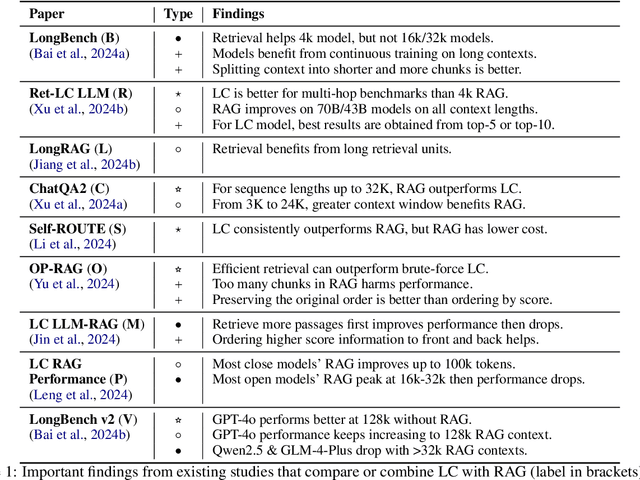
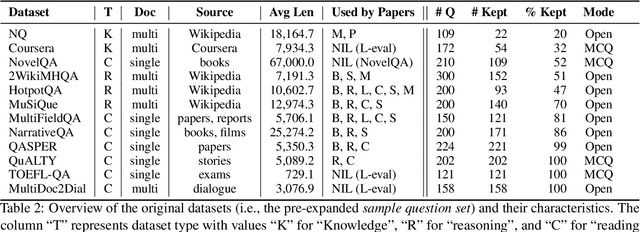
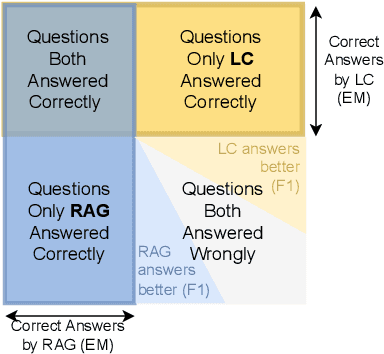
Abstract:Extending context windows (i.e., Long Context, LC) and using retrievers to selectively access relevant information (i.e., Retrieval-Augmented Generation, RAG) are the two main strategies to enable LLMs to incorporate extremely long external contexts. This paper revisits recent studies on this topic, highlighting their key insights and discrepancies. We then provide a more comprehensive evaluation by filtering out questions answerable without external context, identifying the most effective retrieval methods, and expanding the datasets. We show that LC generally outperforms RAG in question-answering benchmarks, especially for Wikipedia-based questions. Summarization-based retrieval performs comparably to LC, while chunk-based retrieval lags behind. However, RAG has advantages in dialogue-based and general question queries. These insights underscore the trade-offs between RAG and LC strategies, offering guidance for future optimization of LLMs with external knowledge sources. We also provide an in-depth discussion on this topic, highlighting the overlooked importance of context relevance in existing studies.
Simulation-Free Hierarchical Latent Policy Planning for Proactive Dialogues
Dec 19, 2024



Abstract:Recent advancements in proactive dialogues have garnered significant attention, particularly for more complex objectives (e.g. emotion support and persuasion). Unlike traditional task-oriented dialogues, proactive dialogues demand advanced policy planning and adaptability, requiring rich scenarios and comprehensive policy repositories to develop such systems. However, existing approaches tend to rely on Large Language Models (LLMs) for user simulation and online learning, leading to biases that diverge from realistic scenarios and result in suboptimal efficiency. Moreover, these methods depend on manually defined, context-independent, coarse-grained policies, which not only incur high expert costs but also raise concerns regarding their completeness. In our work, we highlight the potential for automatically discovering policies directly from raw, real-world dialogue records. To this end, we introduce a novel dialogue policy planning framework, LDPP. It fully automates the process from mining policies in dialogue records to learning policy planning. Specifically, we employ a variant of the Variational Autoencoder to discover fine-grained policies represented as latent vectors. After automatically annotating the data with these latent policy labels, we propose an Offline Hierarchical Reinforcement Learning (RL) algorithm in the latent space to develop effective policy planning capabilities. Our experiments demonstrate that LDPP outperforms existing methods on two proactive scenarios, even surpassing ChatGPT with only a 1.8-billion-parameter LLM.
EvoWiki: Evaluating LLMs on Evolving Knowledge
Dec 18, 2024Abstract:Knowledge utilization is a critical aspect of LLMs, and understanding how they adapt to evolving knowledge is essential for their effective deployment. However, existing benchmarks are predominantly static, failing to capture the evolving nature of LLMs and knowledge, leading to inaccuracies and vulnerabilities such as contamination. In this paper, we introduce EvoWiki, an evolving dataset designed to reflect knowledge evolution by categorizing information into stable, evolved, and uncharted states. EvoWiki is fully auto-updatable, enabling precise evaluation of continuously changing knowledge and newly released LLMs. Through experiments with Retrieval-Augmented Generation (RAG) and Contunual Learning (CL), we evaluate how effectively LLMs adapt to evolving knowledge. Our results indicate that current models often struggle with evolved knowledge, frequently providing outdated or incorrect responses. Moreover, the dataset highlights a synergistic effect between RAG and CL, demonstrating their potential to better adapt to evolving knowledge. EvoWiki provides a robust benchmark for advancing future research on the knowledge evolution capabilities of large language models.
ForgerySleuth: Empowering Multimodal Large Language Models for Image Manipulation Detection
Nov 29, 2024
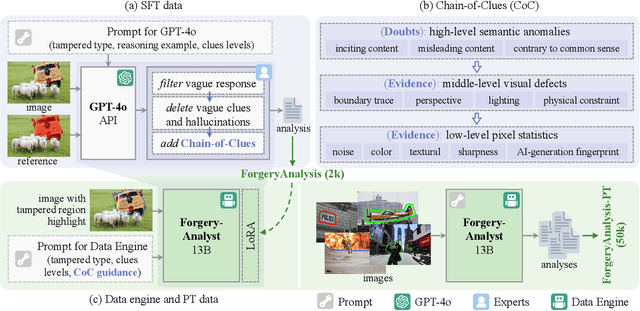
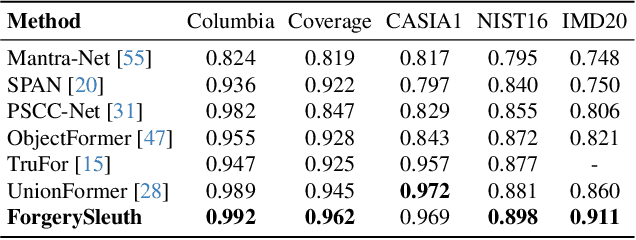
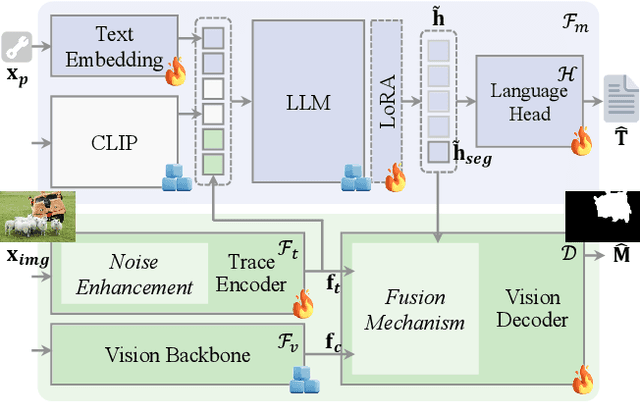
Abstract:Multimodal large language models have unlocked new possibilities for various multimodal tasks. However, their potential in image manipulation detection remains unexplored. When directly applied to the IMD task, M-LLMs often produce reasoning texts that suffer from hallucinations and overthinking. To address this, in this work, we propose ForgerySleuth, which leverages M-LLMs to perform comprehensive clue fusion and generate segmentation outputs indicating specific regions that are tampered with. Moreover, we construct the ForgeryAnalysis dataset through the Chain-of-Clues prompt, which includes analysis and reasoning text to upgrade the image manipulation detection task. A data engine is also introduced to build a larger-scale dataset for the pre-training phase. Our extensive experiments demonstrate the effectiveness of ForgeryAnalysis and show that ForgerySleuth significantly outperforms existing methods in generalization, robustness, and explainability.
Multi-Programming Language Sandbox for LLMs
Oct 30, 2024



Abstract:We introduce MPLSandbox, an out-of-the-box multi-programming language sandbox designed to provide unified and comprehensive feedback from compiler and analysis tools for Large Language Models (LLMs). It can automatically identify the programming language of the code, compiling and executing it within an isolated sub-sandbox to ensure safety and stability. In addition, MPLSandbox also integrates both traditional and LLM-based code analysis tools, providing a comprehensive analysis of generated code. MPLSandbox can be effortlessly integrated into the training and deployment of LLMs to improve the quality and correctness of their generated code. It also helps researchers streamline their workflows for various LLM-based code-related tasks, reducing the development cost. To validate the effectiveness of MPLSandbox, we integrate it into training and deployment approaches, and also employ it to optimize workflows for a wide range of real-world code-related tasks. Our goal is to enhance researcher productivity on LLM-based code-related tasks by simplifying and automating workflows through delegation to MPLSandbox.
RM-Bench: Benchmarking Reward Models of Language Models with Subtlety and Style
Oct 21, 2024



Abstract:Reward models are critical in techniques like Reinforcement Learning from Human Feedback (RLHF) and Inference Scaling Laws, where they guide language model alignment and select optimal responses. Despite their importance, existing reward model benchmarks often evaluate models by asking them to distinguish between responses generated by models of varying power. However, this approach fails to assess reward models on subtle but critical content changes and variations in style, resulting in a low correlation with policy model performance. To this end, we introduce RM-Bench, a novel benchmark designed to evaluate reward models based on their sensitivity to subtle content differences and resistance to style biases. Extensive experiments demonstrate that RM-Bench strongly correlates with policy model performance, making it a reliable reference for selecting reward models to align language models effectively. We evaluate nearly 40 reward models on RM-Bench. Our results reveal that even state-of-the-art models achieve an average performance of only 46.6%, which falls short of random-level accuracy (50%) when faced with style bias interference. These findings highlight the significant room for improvement in current reward models. Related code and data are available at https://github.com/THU-KEG/RM-Bench.
ChartifyText: Automated Chart Generation from Data-Involved Texts via LLM
Oct 18, 2024


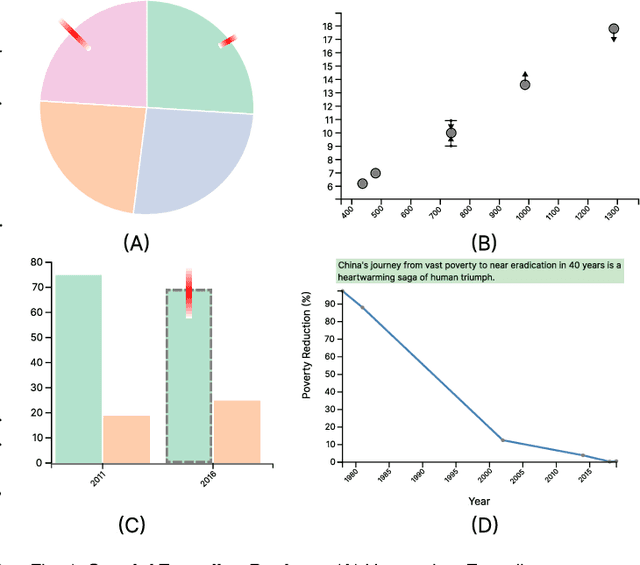
Abstract:Text documents with numerical values involved are widely used in various applications such as scientific research, economy, public health and journalism. However, it is difficult for readers to quickly interpret such data-involved texts and gain deep insights. To fill this research gap, this work aims to automatically generate charts to accurately convey the underlying data and ideas to readers, which is essentially a challenging task. The challenges originate from text ambiguities, intrinsic sparsity and uncertainty of data in text documents, and subjective sentiment differences. Specifically, we propose ChartifyText, a novel fully-automated approach that leverages Large Language Models (LLMs) to convert complex data-involved texts to expressive charts. It consists of two major modules: tabular data inference and expressive chart generation. The tabular data inference module employs systematic prompt engineering to guide the LLM (e.g., GPT-4) to infer table data, where data ranges, uncertainties, missing data values and corresponding subjective sentiments are explicitly considered. The expressive chart generation module augments standard charts with intuitive visual encodings and concise texts to accurately convey the underlying data and insights. We extensively evaluate the effectiveness of ChartifyText on real-world data-involved text documents through case studies, in-depth interviews with three visualization experts, and a carefully-designed user study with 15 participants. The results demonstrate the usefulness and effectiveness of ChartifyText in helping readers efficiently and effectively make sense of data-involved texts.
Grounded-VideoLLM: Sharpening Fine-grained Temporal Grounding in Video Large Language Models
Oct 04, 2024



Abstract:Video Large Language Models (Video-LLMs) have demonstrated remarkable capabilities in coarse-grained video understanding, however, they struggle with fine-grained temporal grounding. In this paper, we introduce Grounded-VideoLLM, a novel Video-LLM adept at perceiving and reasoning over specific video moments in a fine-grained manner. We identify that current Video-LLMs have limitations for fine-grained video understanding since they lack effective temporal modeling and timestamp representation. In light of this, we sharpen our model by incorporating (1) an additional temporal stream to encode the relationships between frames and (2) discrete temporal tokens enriched with specific time knowledge to represent timestamps. To optimize the training of Grounded-VideoLLM, we employ a multi-stage training scheme, beginning with simple video-captioning tasks and progressively introducing video temporal grounding tasks of increasing complexity. To further enhance Grounded-VideoLLM's temporal reasoning capability, we also curate a grounded VideoQA dataset by an automatic annotation pipeline. Extensive experiments demonstrate that Grounded-VideoLLM not only excels in fine-grained grounding tasks such as temporal sentence grounding, dense video captioning, and grounded VideoQA, but also shows great potential as a versatile video assistant for general video understanding.
 Add to Chrome
Add to Chrome Add to Firefox
Add to Firefox Add to Edge
Add to Edge